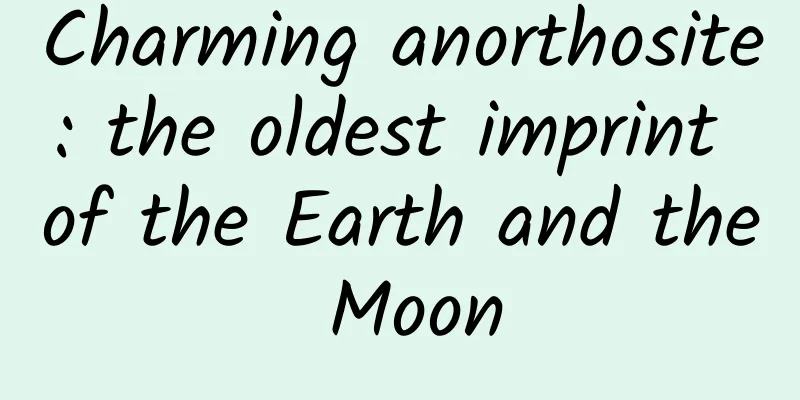Charming anorthosite: the oldest imprint of the Earth and the Moon

|
Speaking of anorthoclase, I believe most people are not familiar with it! Today, I will take you into the world of anorthoclase, to review its past and present, and to feel its unique charm! Beautiful "Labrador Stone" As early as the beginning of the 18th century, the beauty of anorthosite attracted early discoverers. Steinhauer (1814) once recorded the colorful anorthosite in the Labrador Coast area of Canada: "... clear crystals in the lake water, glittering on the cliffs, especially when wet by showers, its color constantly changes with the swaying of the ship, like a glimpse of a scene in fairyland." For a long time thereafter, it was given a lovely name - Labrador stone. Beautiful "Labrador Stone". Picture from the Internet What is anorthosite and what is its "character"? The term anorthosite as it is defined today was first proposed by American geologist Thomas Sterry Hunt in 1863. It refers to a magmatic rock composed almost entirely of plagioclase minerals. It is generally characterized by light color, large crystals, low density, few pores and high hardness. Due to its inherent "character", anorthite is often used as a building or decorative stone. Not only that, it can also be found in aerospace, defense industry, medical equipment, paint and coatings. Thomas Hunt The main uses of anorthosite. Image from the Internet A large and diverse family of anorthosites South African geologist Ashwal (1993) summarized the anorthosite on Earth into five families: ① Archean calcium-rich megacrystal anorthosite 2.5 billion years ago; ② Proterozoic lithic anorthosite with an average age of about 1.3 billion years; ③ layered anorthosite; ④ anorthosite in the marine environment; ⑤ anorthosite inclusions in other igneous rocks. Among these five families, Archean and Proterozoic anorthosites are the main body of the earth's anorthosites and are also one of the oldest rocks on earth. Among them, the Proterozoic anorthosite is the most famous, and in my country, only the Damiao anorthosite in Chengde, Hebei Province belongs to this type. The other three families are produced in other igneous rocks and have appeared in various geological periods. Upper left: Archean megacrystals and white calcic plagioclase megacrystals. According to Ashwal and Bybee (2018); Lower left: Anorthosite (lighter color) in the Bushveld layered mafic complex in South Africa. Image from http://www.35igc.org/Page/372/Pre-7-Eastern-Limb-of-the-Bushveld-Complex-August-2016; Upper and lower right: Proterozoic anorthosite specimens from the Duluth Proterozoic pluton in Minnesota, USA. Image from homestead.com. "Angola Black", a special anorthosite In faraway Angola in Africa, where we used to work, there is a kind of high-grade natural stone that is very popular among consumers, and that is "Angola Black". The pure "Angora Black" comes from a special black anorthite, which comes from the largest anorthite body on earth - the Cunene anorthite. The reason why "Angora Black" is special black is that the plagioclase contains a large number of needle-shaped or star-shaped iron-titanium oxide inclusions. As described by Steinhauer in the previous article, whenever night falls or it is soaked in water, "Angora Black" will also emit a little blue fluorescence. This is due to the presence of a special variant in the plagioclase crystal - labradorite, a special plagioclase that can refract rainbow-like colors. Geologists have given this phenomenon a considerate name - "labradorite iridescence". The blue "labradorite iridescence" adds a touch of mystery and romance to the originally deep and solemn black rock. The mysterious and romantic labradorite crystals are often used in gemstone processing, while iron-titanium deposits such as "Angora Black" are one of the main sources of titanium metal in the world. The home of “Angola Black” - Kunene Anorthosite Complex (Geological map of the Kunene Anorthosite Complex in Angola/Namibia modified from Lehmann et al. (2020)) Finished "Angora Black" stone slab (left); Blue labradorite iridescence in "Angora Black" stone slab (right) Labradorite jewelry (left); ilmenite associated with anorthite (right). Image from the Internet How did the Earth and terrestrial planets evolve? What is their ultimate fate? Anorthosite will answer your questions. Plagioclase is not unique to Earth. In 1969, humans first discovered lunar plagioclase in the lunar rock samples returned by Apollo 11. As an important component of the lunar terraces, its composition is similar to that of the Archean plagioclase on Earth. Therefore, scientists believe that plagioclase may be the earliest rock type on the Earth's surface, and the classic "magma ocean model" came into being. Left: Lunar seas and lunar terraces. Anorthosite is an important component of lunar terrace rocks; Right: Locations of NASA's Apollo 11–17 landing sites and a close-up of the Apollo 16 landing site. Left: Lunar terrestrial anorthite (“Origin Stone” 15415); Right: Archean anorthite (Greenland Anorthite Mining Company, Denmark). The picture comes from the Internet With the development of aerospace industry and the rapid advancement of isotope dating technology, scientists have discovered that more than 99% of lunar rocks are much older than Earth rocks. Among them, lunar terrestrial plagioclase is even older, with an age of 4.29-4.57 billion years. This completely overturns the traditional perception that "the Earth is the Moon's elder", and at the same time further inspires more imagination about the origin and evolution of the Earth and the Moon. Left: The oldest rock on Earth, 4.03 billion years old, Acasta gneiss in Canada; Right: Lunar anorthosite collected by Apollo 16, 4.29-4.57 billion years old. Image from the Internet I believe that with the implementation of my country's "Chang'e Project", it will help to further improve and update people's understanding of the early history of the Earth, the Moon and other terrestrial planets, and further answer their final fate. And anorthite will eventually play an indispensable and important role. China's lunar exploration program. Image from the Internet Main references 1. Ashwal L D. Anorthosites. Berlin Heidelberg: Springer. 1993. 2. Ashwal LD and Bybee G M. Crustal evolution and the temporality of anorthosites (vol 173, p. 307, 2017) [J]. Earth-Science Reviews: The International Geological Journal Bridging the Gap between Research Articles and Textbooks, 2018(180-): 180. 3. Ashwal LD and Twist D. The Kunene complex, Angola/Namibia: a composite massif-type anorthosite complex. Geological Magazine, 1994. 131(5): p. 579–591. 4. Lehmann J, et al. Emplacement of the giant Kunene AMCG complex into a contractional ductile shear zone and implications for the Mesoproterozoic tectonic evolution of SW Angola. International Journal of Earth Sciences, 2020. 109(15): p. 1463–1485. 5. Xu X. et al. Formation of lunar highlands anorthosites. Earth and Planetary Science Letters. 2020. 536: p. 116–138. 6. Chen Wei, Zhao Taiping. Characteristics and research status of Proterozoic anorthosite[J]. Geological Journal of Colleges and Universities, 2007. 13(1):117–126. 7. Zhang Zhaochong. Genesis of Proterozoic anorthosite and its Fe-Ti-P deposits[J]. Bulletin of Mineralogy, Petrology and Geochemistry, 2018. 37(6): 1047–1061. |
>>: 40 kilometers above the sky, scientists want to release a "balloon" to serve as an observatory
Recommend
12 channels for selling goods through live streaming!
Previously, I shared with you how to build a circ...
From fuel vehicles to new energy vehicles, BMW and Mercedes-Benz will always be Audi's rivals
When talking about Audi, we naturally think of Me...
The new drug was terminated early because the effect was too obvious.
Anticoagulation is required to treat atrial fibri...
Welcome the God of Wealth on the 5th day of the New Year|The Gods of Wealth from ancient times to the present, all explained to you in one breath →
It is the day to welcome the God of Wealth on the...
International Rabbit Day | Rabbits have red eyes? Do they love carrots? Actually…
The fourth Saturday of September every year is In...
Those foods you think are junk can actually be eaten boldly!
appendix: This article was reviewed by: Pa Lizhe,...
How to operate an event (Part 2)
How to operate an event (Part 1) To operate produ...
Credit card interest suspension installment conditions
Credit card interest suspension installment condi...
AirPods wish list? Analysts mention these three
Apple's launch of AirPods was not smooth saili...
The essence of brand operation, using F4 to crack Steve Jobs' reality distortion
Today we are going to talk to you about how brand...
The 6 underlying logics of brands behind Douyin’s full-case launch!
In recent years, new brands have risen rapidly, n...
Brand marketing promotion: Analysis of Marvel IP’s brand positioning strategy!
To be or not to be? That is the question. There a...
How to earn $80,000 a month on the App Store?
Apple announced at the World Developers Conferenc...
What does Doraemon, who has big buck teeth, hide in his pocket?
Australia is a magical land. There are kangaroos,...
How to create a landing page with high conversion rate? Share 2 pictures!
Unlike traditional industries that can bring prod...









